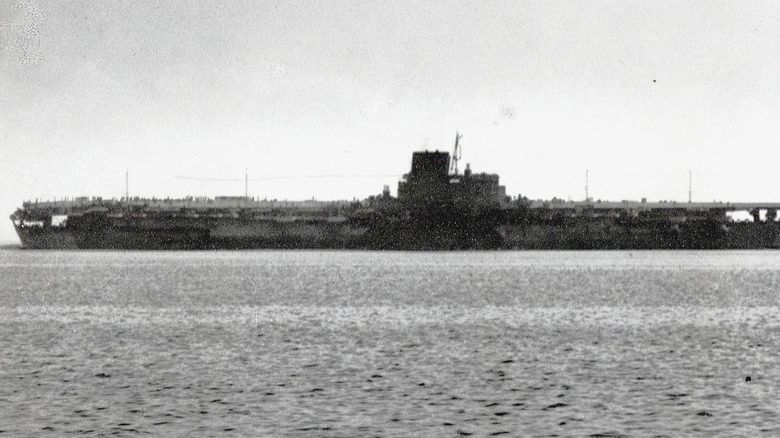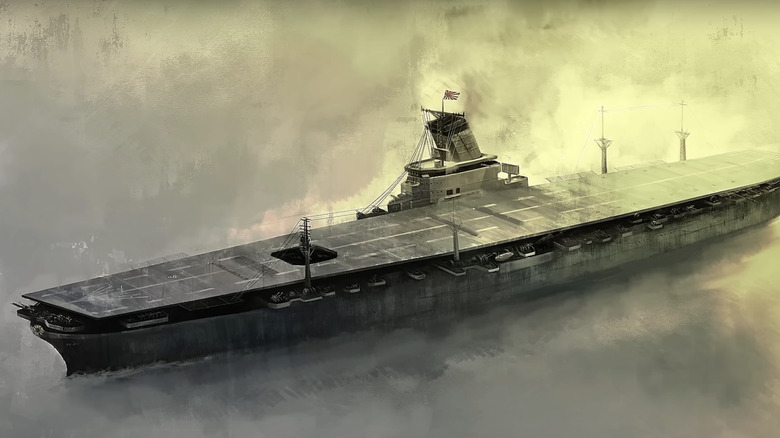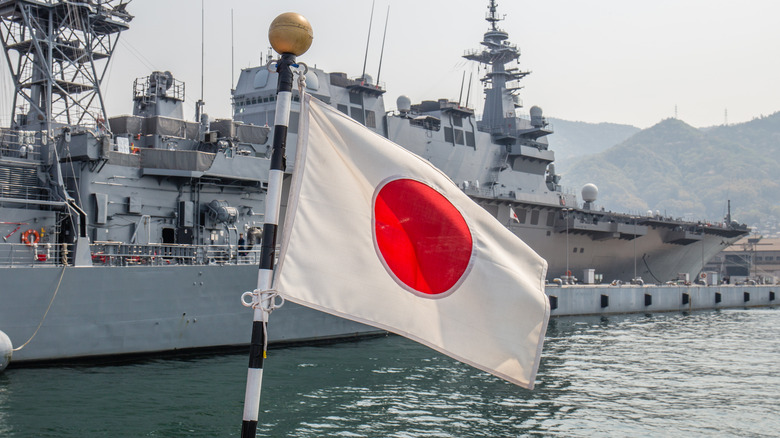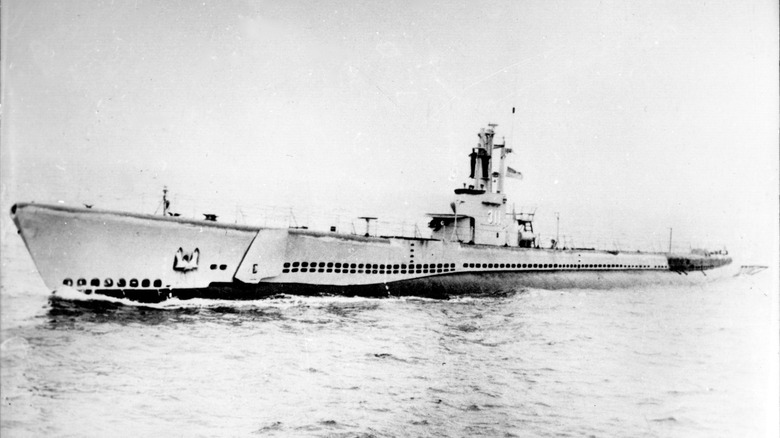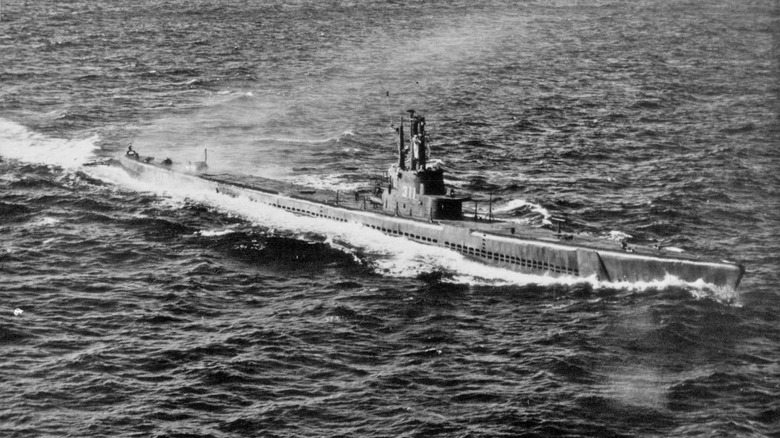What Was The Largest Japanese Aircraft Carrier Ever And How Did It Sink?
Of all the countries that have aircraft carriers, one could argue that Japan is technically not on that list, as the country exclusively operates helicopter carriers. That wasn't always the case, though. In World War II, the small island nation operated a couple of aircraft carriers, including the Shinano. Named after a medieval Japanese province, the Shinano had a displacement of 68,000 tons, a length of 872 feet, a 119-foot beam, room for 2,400 sailors, and accommodations for 47 fighter planes and 120 reserve aircraft. While 872 feet is nothing compared to the 1,106 feet that the world's largest aircraft carrier today is, the Shinano was the second largest ship of its time.
Unlike other aircraft carriers that were on the front lines and typically the flagship of a fleet, though, Japan had different plans for the Shinano. It served as a support vessel for its fleet where damaged planes would land to receive repairs, fuel, and munitions. Interestingly, the original plan for the carrier didn't envision the Shinano with its own aircraft, giving it only enough space to take planes from other carriers.
However, there were some within the Imperial Navy who didn't agree with this mission. The supercarrier not having its own aircraft onboard was a real sticking point, so after much debate, the powers-that-be compromised and carved out space on the ship for fighter planes. It would still operate as a support vessel, but carrying 47 planes gave it additional defensive capabilities it wouldn't have had prior.
Shinano wasn't always an aircraft carrier
During World War II, Japan had a bit of a shortage of aircraft carriers. The Japanese sent four of its carriers to attack the U.S. base on Midway in 1942, initiating the famed Battle of Midway. While the Japanese dealt a serious blow to the American forces there, the immediate counter offensive by the nearby U.S. carrier fleet was crippling. So, the Imperial Japanese Navy decided to convert one of its battleships, the Shinano, into the largest carrier in its fleet.
The Shinano was originally going to be a 70,000-ton battleship, joining two other similarly built ones known as the Musashi and the Yamato. However, with the destruction of the four carriers in the Battle of Midway and less of a need for more battleships, converting the Shinano became a priority. Shinano's conversion was a slow-going process that started in the middle of 1942 and didn't finish until October 1944.
It was originally scheduled to finish in 1945, but the Japanese forced themselves to hurry with the conversion after the Battle of the Philippine Sea in 1944, when two more carriers were lost. Those building the Shinano had to work 16-hour shifts, as It became crucial that the supercarrier be seaworthy sooner than it's predetermined launch date.
Shinano was equipped with an impressive defense lineup
Originating as a battleship, the Japanese already intended to equip the Shinano with an impressive layout. Naturally, that changed slightly when they decided on its conversion, but it's no less impressive. On top of an 8-inch-thick belt of armor around its hull and 2.95 inches of armor designed to protect the flight deck from bombings, it was also armed with 16 5-inch guns, 145 25-mm cannons, 12 4.7-inch anti-aircraft rocket launchers, and of course its more than 40 onboard planes.
The four steam turbines on the Shinano could get the ship up to 27 knots of speed and produce 150,000 horsepower, giving it plenty of speed to keep up with the rest of the fleet. While nothing compares to how long nuclear aircraft carriers today can stay at sea before refueling (roughly 25 years), the Shinano could travel up to 10,000 miles before needing to top off.
Its armor was especially helpful since the carrier was so large and made for an easy target. At one point, Japan wanted to move the Shinano and its port because of how large a target it was. The U.S. was regularly conducting runs with B-29 bombers in the area, and it seemed risky to keep it there.
The Shinano's first journey was its last
As great of an achievement as the Shinano was for Japan, it wasn't without its flaws. For starters, it was a giant target for enemy forces. Sure, it could protect itself pretty well against enemy aircraft and even do pretty well against other surface ships. What it wasn't ready for was an attack from below the water line, which is how the Shinano met its end.
The Shinano's maiden voyage after being commissioned by the Japanese Navy was a risky one. It set sail with its military personnel in addition to 300 civilian ship workers who had to complete the few construction tasks the carrier still needed. With only eight of its 12 boilers in working order, the carrier couldn't reach full speed, putting the ship's skipper on edge.
The Shinano had to get to the port in Kure, located on the west end of Japan, where it would be safe from enemy bombings. However, the journey there was a treacherous one. Shinano's size alone allowed the U.S. submarine, the Archerfish, to spot it on radar 12 miles away. Although it was night, the moon was full and bright, giving anyone on the open sea clear sight of their targets. One lookout on the carrier reportedly thought he saw a periscope, but was dismissed by his peers. When one of the destroyers broke formation, it was the beginning of the end.
U.S. torpedos sunk the Shinano in a sneak attack
Soon, crew members confirmed the target was an aircraft carrier — one larger than they had ever seen before. The Archerfish gave chase to the Shinano on the night of November 28, 1944, but since the submarine wasn't as fast as the carrier, the U.S. Navy eventually lost sight of its target. Only when the Shinano decreased speed and changed its course did the Archerfish pick up its target on radar again.
The Shinano's captain, Toshio Abe, spooked himself into thinking a group of submarines were nearby just north of him. So, after picking up a transmission from the Archerfish to Pearl Harbor, the Shinano opted to head south, away from the submarine squadron that wasn't there and instead headfirst into the lonesome Archerfish. Now submerged, the Archerfish completely bypassed one of the Shinano's escorts. At around 3 a.m., the Archerfish's captain confirmed the carrier was in their line of sight, fired off a barrage of torpedoes, then dove to a depth of 400 feet.
Six torpedoes raced toward the carrier's starboard side where four of the six made impact. While it should have taken more than four torpedoes to sink the carrier, three of them punctured vital spots in the hull that flooded a turbine room, a boiler, an oil tank, and the air compressor room. Despite Abe's best efforts, the Shinano sank by 10:55 a.m., with the captain being among the 1,435 men who went down with her.
